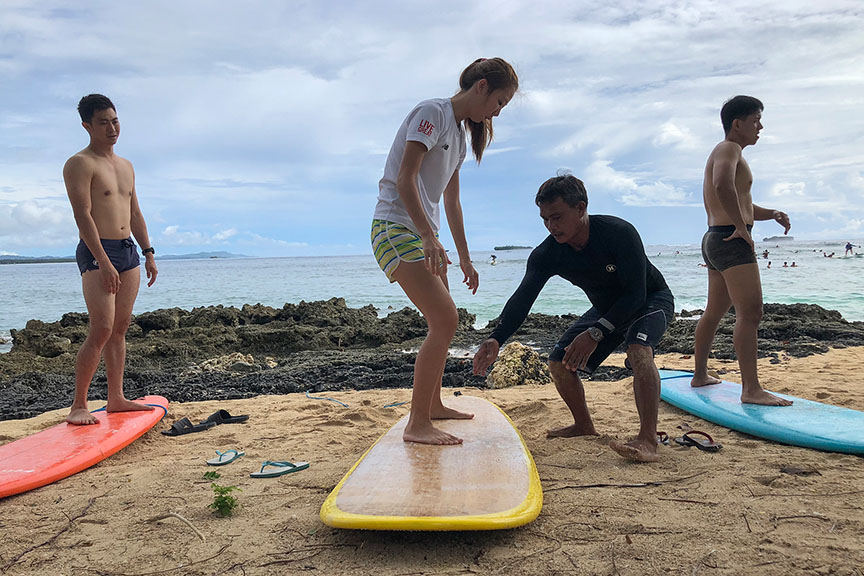GENERAL LUNA, Siargao Island (MindaNews / 23 June) – From getting stoked to becoming economically choked, a few hundred surfing instructors in the world-renowned surfing capital of the Philippines are in dire straits.
 Foreigners get lessons from a surfing instructor in General Luna, Siargao. MindaNews file photo by ROEL N. CATOTO
Foreigners get lessons from a surfing instructor in General Luna, Siargao. MindaNews file photo by ROEL N. CATOTO
When the dreaded coronavirus disease (COVID-19) hit the country, transportation to and from the idyllic island was crippled, resulting in unimaginable suffering among residents, surfers included.
Its socio-economic impact resonates among surfing instructors in the island.
Teaching being their bread and butter, the surfers admit to facing uncertainty in these trying times.
Prudencio “Pitao” Meras III, one of the surfing instructors of Gwapitos, a premier surfing school of Kermit Restaurant and Accommodation in the municipality of General Luna, said that COVID-19 has left him displaced.
“I’ve been out of work since mid-March when the government ordered a lockdown,” he said in the vernacular.
Meras, 24, who lives with his partner and their three-year-old daughter, said that his sari-sari store, which was the family’s source of income, has closed down.
He moved with his family to Dapa town and now sells barbecue in a densely populated village to make ends meet.
Before the pandemic, Meras normally earned between P500 and P1,000 per day.
Surfing lessons cost P500 per hour for each session. If the surfer instructor doesn’t own a surfboard, as an instructor he gets P300 per hour and the P200 goes to the surfboard owner.
Manuel Melindo, president of the Siargao Island Surfers Association (SISA), told this writer today that there are 455 surfing instructors on the island.
SISA once gave an aid to all surfing instructors but their funds coming from donations were not enough.
“Miserable life, I should say. These people are breadwinners, and when the pandemic hit, instantly they became dependent on whoever would give them something,” Melindo said. “Majority of them have no health insurance or social security,” he added.
Meras may be in a quicksand of agony now due to the pandemic, but this tough life he is encountering now is not new to him.
“During the times when Siargao Island wasn’t that popular, we were very poor. But life was okay back then, because we could get food in our surroundings,” he said, adding that land crabs locally known as “kayabang” was aplenty.
Meras said that when the influx of tourists came in, these supposed perpetual food resources available around have drastically declined due to massive developments in the surfing capital.
“Our delicate ecosystem has continued to tear apart irreparably due to rapid development,” he lamented.
“These could have been a standby lifeline resource in a pandemic or natural disaster,” he added.
(Roel N. Catoto / MindaNews)
